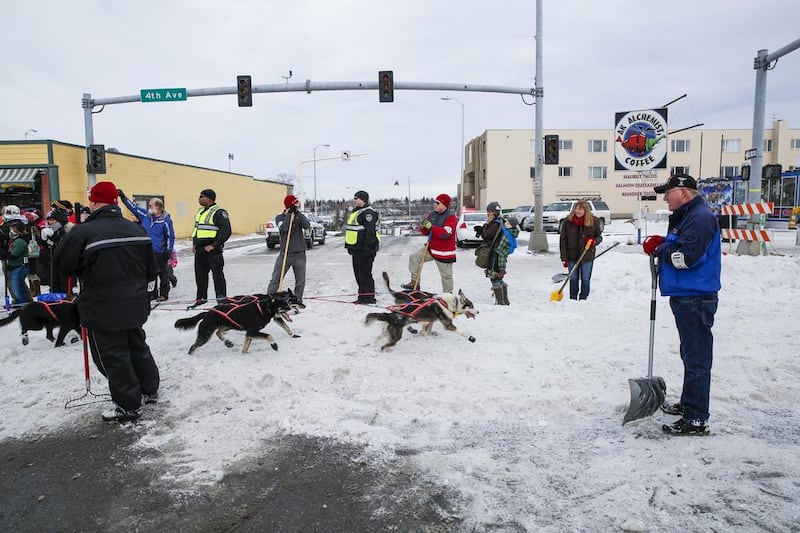PHILADELPHIA // The Iditarod dogsled race, which runs over 10 days every March in Alaska, is facing an unusual problem: not enough fresh snow.
Before the nearly 1,600-kilometre race kicked off in Anchorage last Sunday, tonnes of snow had to be brought in by train from Fairbanks in case the route for the pre-race parade needed an additional layer. In the end, the snow was not used, but the parade’s usual 18km route was cut to just five kilometres.
As the 25 sled teams mush north towards Nome, they are encountering spots along the trail where the fresh snow cover is very shallow or even non-existent. In these spots, they are gliding along “old snow”, left over from snowfalls in October or November.
In the interior of the state, away from the coast, "most areas have had record or near-record low snow since December", Rick Thoman, the climate science and services manager for the National Weather Service in Alaska, told The National. Last year was even worse: "Snow cover is in better shape than last spring over much of mainland Alaska," he said.
This winter and the previous two are among the six warmest since 1925 in the US state. February saw an average temperature of –1°C in Anchorage, almost six degrees above average.
“Signs of long-term environmental change are ubiquitous in Alaska,” Mr Thoman said. “Wildfires are increasing, summers are becoming too warm to support the existing boreal forest composition in parts of the interior. In south-east Alaska, some tree species are threatened due to a decline in winter snow cover.”
As the world tries to limit global warming to 1.5°C above pre-industrial levels as agreed at the Paris climate summit last year, Alaska might well be a bellwether of how rapid warming will affect human activity.
Last August, president Barack Obama picked the US state as the stage from which to issue one of his most dire warnings on climate change. “On this issue – of all issues – there is such a thing as being too late,” he said. Ignoring the problem will “condemn our children to a planet beyond their capacity to repair”.
Alaska, which accounts for 20 per cent of the total land area of the United States, has seen its average temperature rise by at least 1.6°C over the past 60 years – twice the rate of warming seen elsewhere in the country.
The steep warming curve is particularly worrying because the state’s “average temperatures are so near freezing”, the National Oceanic and Atmospheric Administration (NOAA) said in a 2013 report. “A small change in temperature can result in large impacts.”
The report outlined some of the ways in which a warmer Alaska could affect human activity.
“Tourism depends partially on the presence of healthy, beautiful forests while the lumber industry relies on live, healthy trees,” NOAA said. “Increasing temperatures ... have resulted in increased overwinter survival of bark beetles, and a consequent increase in the number of acres of forest destroyed by these insects.”
Retreating Alaskan glaciers threaten freshwater supplies as there is less ice to leave behind water during the glaciers’ melting periods. A warming ocean, meanwhile, encourages the contamination of oyster beds by parasites and bacteria.
“Climate change leads to more permafrost thaw and disruptions to freeze-thaw cycles,” the US Environmental Protection Agency warns on its website. “This can potentially cause damage to transportation infrastructure in Alaska, including highways, railroads, and airstrips.”
The most serious signals may be emerging not from snow on a dogsled trail, however, but from deep underground.
Vladimir Romanovsky, a professor at the University of Alaska and the head of the Global Terrestrial Network for Permafrost, has used boreholes to study permafrost – permanently frozen soil that has remained below freezing for a minimum of two years.
Permafrost can lie just below the surface, or it can lie hundreds of metres deep. "Lower temperature means stable permafrost," Dr Romanovsky told The National.
In northern parts of Alaska, the temperature of permafrost has risen by 3°C over the past 30 years. “In some locations, permafrost has already started to thaw,” he said. “When ice-rich permafrost thaws, the ice turns to water, and the water drains away, causing the ground to sink. This affects anything sitting on the ground surface: trees, houses, roads, pipelines.”
He said a full melt of the permafrost in Alaska might occur around 2060-2070.
Dr Romanovsky sees the change around him too. “This is the first time in the 24 years that I have lived here in Alaska that it has been so warm,” he said of the current winter.
Given Alaska’s size, its residents experience climate change in different ways, he said.
Subsistence whale hunters in Barrow – located above the Arctic Circle – have concerns quite different from the population of Anchorage, the state’s largest city. Whale routes change as the oceans warm, causing problems for those who hunt them.
“Some people are not involved in the Iditarod at all, they don’t have dogs and aren’t interested in the historical significance of this race, so they may not have an opinion,” on the lack of fresh snow, he said. “However, most of the people in Alaska understand that these recent changes are part of a bigger change in our world.”
ssubramanian@thenational.ae





